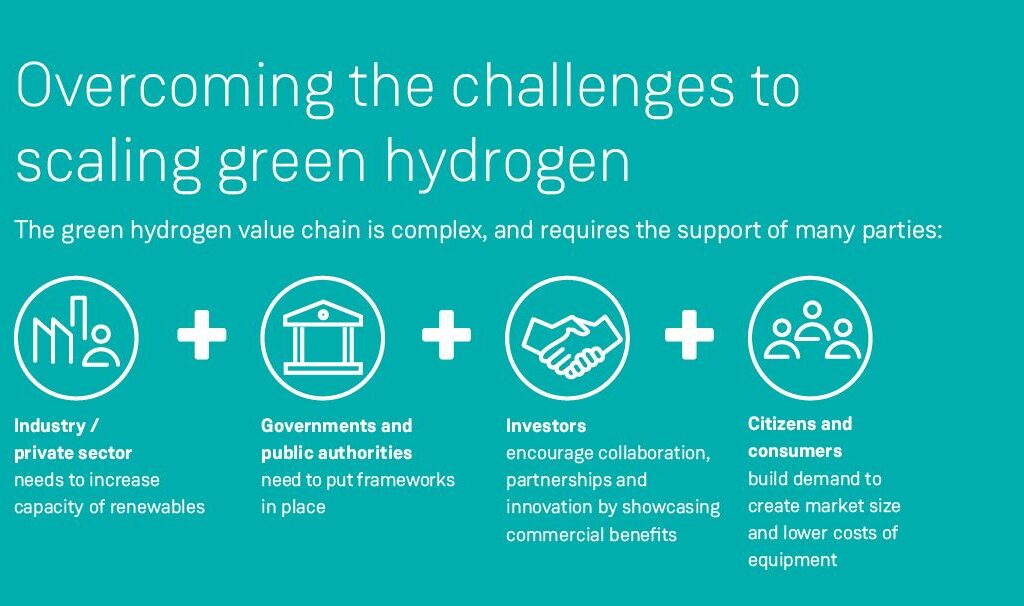
Green Hydrogen is stepping into the limelight in the transformative era of energy evolution, promising a carbon-neutral future. The global green hydrogen market is expected to reach $2.28 billion by 2026, growing at a CAGR of 14.24% from 2021; the landscape is brimming with potential. However, navigating the undercurrents of challenges is crucial to unleashing its full potential and ensuring its pivotal role in the global energy tapestry. Some of these challenges are:
- The Economic Quandary: Cost Competitiveness and Investment
Green hydrogen, while environmentally superior, grapples with economic hurdles. Production costs hover between $2.50 to $6.80 per kilogram, shadowed by grey hydrogen’s affordability at $1 to $1.80 per kilogram. Bridging this cost gap is vital to ensuring its widespread adoption and competitiveness in the energy market. A case study to explain the same is:
Germany’s Hydrogen Strategy:
Germany’s commitment of €9 billion to its National Hydrogen Strategy is a bold stride towards economic viability. Aiming to scale production capacity to 5 GW by 2030 and 10 GW by 2040 and fostering innovation, Germany’s approach is multifaceted. The strategy encompasses subsidies for green hydrogen production, investments in R&D, and international partnerships, such as with Morocco, to secure renewable energies for hydrogen production.
2. Technological Evolution: Efficiency, Durability, and Scalability
The technological fortification of electrolyzers, especially PEM and Alkaline Electrolyzers, is central to green hydrogen production. Current efficiencies are around 60-80% and intend to reach above 90% to make green hydrogen a staple in the energy mix. An understanding of the above can be understood with the help of a case study of:
ITM Power and the Refhyne Consortium:
In collaboration with Siemens, Shell, and other partners, ITM Power is making significant technological headways. The Refhyne project, with an investment of €20 million, aims to deploy the world’s largest PEM electrolyzer at Shell’s Rhineland refinery. This consortium represents a vital step towards demonstrating the scalability and efficiency of electrolyzer technology to achieve a 10% hydrogen blend in the gas grid.

3. Infrastructure Retrofitting and Innovation:
Infrastructure overhaul for green hydrogen involves considerable investments. The global cost to develop hydrogen infrastructure is estimated to be between $11 trillion and $15 trillion by 2050. Adaptation and innovation are vital in facilitating the shift towards a hydrogen-powered future. A case study to explain this is of California.
California’s Hydrogen Highway Initiative:
California’s “Hydrogen Highway” project, backed by $230 million in funding, aims to establish a comprehensive network of hydrogen refuelling stations. The initiative has facilitated the deployment of over 8,000 fuel cell vehicles and the installation of 45 hydrogen refuelling stations, with plans for more in the pipeline, thereby addressing supply and demand facets of the infrastructure challenge.
4. Regulatory Synchrony and Policy Incentives:
A harmonized regulatory landscape is pivotal for green hydrogen. The European Commission estimates that achieving a renewable hydrogen-based energy system in Europe would require €180-470 billion in investments by 2050. An understanding of the same can be through:
European Union’s Comprehensive Green Hydrogen Strategy:
The EU’s hydrogen strategy encompasses a robust plan to install 40 GW of electrolyzer capacity by 2030 and facilitate the production of up to 10 million tons of green hydrogen. By aligning policies, regulations, and incentives across member states, the EU is laying down a foundational framework for integrating and expanding green hydrogen.
Therefore, as we navigate the green tide, the blend of challenges and opportunities shapes the voyage towards a green hydrogen-powered future. The infusion of significant investments, technological advancements, infrastructural developments, and regulatory harmonization paints a promising picture. With green hydrogen poised to meet 24% of global energy needs by 2050, each challenge surmounted, and each success story penned is a beacon of hope, illuminating the path towards a sustainable and harmonious future. The journey is intricate, but the collective resolve and innovative spirit showcased by nations and corporations are crafting a narrative of progress and possibility.
PS: Image source unknown, due credits!



Your posts always provide me with a new perspective and encourage me to look at things differently Thank you for broadening my horizons
Your posts always provide me with a new perspective and encourage me to look at things differently Thank you for broadening my horizons
Your posts always provide me with a new perspective and encourage me to look at things differently Thank you for broadening my horizons
Your posts always provide me with a new perspective and encourage me to look at things differently Thank you for broadening my horizons